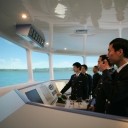消防基本英语2 - 请对照学习
以下是我在做实习生的时候摘录的一些基本消防知识,大家可以结合中文教材学习
希望各位贤兄有所收获
^_^ 获取晋级 :)P
To extinguish a fire successfully, it is necessary to use the most suitable type of
extinguishing agent-one that will accomplish the task in the least amount of time, cause the
least damage and result in the least danger to crew members. The job of selecting the proper
extingushing agent has been made easier by the classification of fires into four types, or
classes, lettered A through D. Within each class are all fires involving materials with
similar burning properties and requiring similar extinguishing agents. Thus, knowledge of
these classes is essential to efficient firefighting operations, as well as familiarity with
the burning characteristics of materials that may be found aboard ship.
NFPA CLASSES OF FIRE
the fire classification sheme used by the U.S. Coast Guard was originally devised by the
National Fire Protection Association (NFPA). in this scheme, fires are classed according to
the fuel and the most effective extinguishing agents, as follows:
A class A fires: fires involving common (ash-producing) combustible materials, which can be
extinguished by the use of water or water solutions. Materials in this category include wood
and wood-based materials, cloth, paper, rubber and certain plastics.
B class B fires: fires involving flammable or combustible liquids, flammable gases, greases
and similar products. Extinguishment is accomplished by cutting off the supply of oxygent to
the fire or by preventing flammable vapors from being given off.
C class C fires: fires involving energized electical equipment, conductors or appliances.
Nonconducting extinguishing agents must be used for the protection of crew members.
D class D fires: fires involving combustible metals, e.g., sodium, potassium, magnesium,
titanium and aluminum. extinguishment is effected through the use of heat-absorbing
extinguishing agents such as certain dry powders that do not react with the burning metals.
The main objective of this classification scheme is to aid crew members in selecting the
appropriate extinguishing agent. However, it is not enough to know that water is best for
putting out a class A fire because it cools, or that dry chemical works well in knocking
down the flames of a burning liquid. The extinguishing agent must be applied properly, and
sound firefighting techniques must be used.
extinguishment of class A fires
it is a fortunate coincidence that the materials most often involved in fire, class A
materials, may best be extinguished by the most available extinguishing agent, water. U.S.
Coast Guard regulations specify a system whereby water will be available for firefighting
purpose be requiring that firemain system be installed on self-propelled vessels.
extinguishment of class B fires
U.S. Coast Guard regulations provide for the installation of firemains and fixed fire-
fighting systems using foam, carbon dioxide, steam and water spray in appropriate locations.
in addition, foam, dry chemical, carbon dioxide and water extinguishers of various size and
protability must be placed in specified areas throughout the ship.
the source of the flammable or combustible liquid involving in fire should be cut off as
soon as possible (and if possible). This will halt the supply of fuel feeding the fire, and
allow fire-fighters to employ the following general methods of extinguishment:
..cooling. using water from the firemain system, in spray or solid-stream form, to cool
tanks and exposed areas.
..smothering. using foam to blanket the liquid and thus shut off the supply of oxygen to the
fire; discharging steam or carbon dioxide into burning areas; eliminating oxygen by sealing
off the ventilation to the fire.
..inhibiting flame propagation. Applying dry chemicals above the burning su***ces.
It is difficult to establish rigid procedures for extinguishing specific type of fires,
since no two fires are alike. However, the following general guidlines apply for fires
involving flammable and combustible liquids:
..minor spills: use dry chemical or foam extinguishers, or water fog.
..large spills: use large dry chemical extinguishers, backed up by foam or fog lines. Use
water stream to protect objects that are exposed to fire.
..spills on water: if contained, use foam to smother fire. Otherwise use large-volume fog
stream.
..sighting or ullage ports: apply foam, dry chemical or high- or low-velocity water fog
horizontally across the opening until it can be closed.
..cargo tanks: use the deck foam system and/or carbon dioxide or steam smothering system, if
so equipped. water fog may be used for heavy oils.
..ship's galley: use carbon dioxide or dry chemical extinguishers.
..oil-burning equipment: use foam or water fog.
extinguishment of paint and varnishes fires
because liquid paints contain low-flash-point solvents, water is not a suitable
extinguishing agent. Foam must be used if any substantial quantity if paint if involved.
surrounding materials may have to be cooled with water. on small quantities of paint or
varnish, a carbon dioxide or dry chemical extinguisher may be used in place of a foam
extinguisher. water is the proper extinguishing agent for dry paint.
extinguishment of flammable gas fires
flammable gas fires can be extinguished with dry chemicals. Carbon dioxide and vaporizing
liquids may extinguish certain gas firs. However, these fire present a severe radiant heat
hazard to firefighting forces, Additionally, there is the danger of the gas continuoing to
escape after the fire is extinguished, thus creating another fore and explosion problem. Dry
chemical and water spray offer good heat shields from the radiant heat of gas fires while
CO2 and vaporizing liquid do not.
the standard procedure for control is to allow the gas to burn until the flow can be shut
off at the source. Extibguishment should not be attemples unless such extinguishment leads
to shutting off the fuel flow. Until the flow of gas supplying the fire has been stopped,
firefighting efforts should be dorected toward protecting exposures. (exposures are
combustible materials that may be ignited by flames or radiated heat from the fire. water in
the form of straight streams and fog patterns is usually used to protect exposures.) when
the gas is no longer escaping from its container, the gas flames should go out. however,
where the fire was extinguished before shutting off the gas flow, firefighters must be
careful to prevent the ignition of gas that is being raleased.
extinguishment of class C fires
when any type if electrical equipment is involved with fire, its circuit should be
deenergized. however, whether the circuit is deenergized or not, the fire must be
extinguished using a non-conducting agent, such as fry chemical, CO2, or Halon. firefighters
should always consider an electrical circiut to be energized. the use of water in any form
is not permitted. firefighters must wear appropriate breathing devices when entering spaces
where electrical equipment has been burning since toxic gases are given off by burning
electrical insulation.
crew members must remember two things when combating electrical fires: first, all electrical
equipment in the fire area must be treated as "live" until it is known that the deenergizing
process has been completed. Second, breathing apparatus must be worn because of the toxic
gases given off by burning insulation and metal wiring.
extinguishment of class D fires
fires involving most metals present an extinguishment problem to firefighters. frequentlu
there is a violent reaction with water, which may result in the spreading of the fire and/or
explosion. if only a small amount of metal is involved and the fire is confined, it may be
advisable to allow the fire to burn itself out. exposures should, of course, be protected
with water or another siutable extinguishing agent.
some synthetic liquid have been employed in extinguishing metal fires, but these are not
usually found aboard ship. the ABC or multipurpose dry chemical extinguisher has been used
with some success on fires involving metals. such extinguishers may be available to
shipboard firefighters.
sand, graphite, various other powder extinguishing agents and salts of different types have
been applied to metallic fires with varying success. no one method of extinguishment has
proven effective for all fires involving metals.
-----------------------------------------------------
2nd Officer
Ever-student from Dalian Maritime University
Be proud of DMU
请登录后发帖

 联系我们人工客服
联系我们人工客服



















 :1391995811
:1391995811

